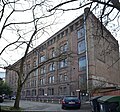B. Dondorf
B. Dondorf was a printing company based in Frankfurt am Main . The company was a leading manufacturer of playing cards . The company building, the Dondorf print shop in Frankfurt-Bockenheim , is part of the Route of Industrial Culture .
Company history
The lithographer and printer Bernhard Dondorf founded the B. Dondorf company on April 2, 1833 as a printing and trading company in Saalgasse 27 in Frankfurt. He specialized in high-quality print products. From 1839 playing cards were mainly produced here. In addition, luxury papers, but also board games were produced. The high quality of the lithographs made here led to the founding of the sister company Dondorf & Naumann in 1850 (together with Carl Christian Otto Naumann ), which became a leading manufacturer of securities and banknotes. In 1854 a steam engine was purchased.
In 1872 Bernhard Dondorf left the company. His sons Carl (1844–1936) and Paul (1848–1904) and son-in-law Jacob Fries (Anna Dondorf's husband (1850–1927)), who left in 1890, were his successors at the top of the company. Carl Dondorf joined the company in 1860 and was responsible for the technical management. Paul Dondorf was responsible for commercial issues.
At the end of 1905 the company was converted into a GmbH and now traded as B. Dondorf GmbH, Frankfurt a. M. The owners were now Carl and Otto Dondorf (Otto was the son of Paul Dondorf) and Marie Dondorf. In 1905 the company employed 290 workers and 260 women.
The First World War led to a decline in business. In 1920 only 560 workers were employed. In 1925, Carl Dondorf left the company due to old age. Over 9 million card games were sold in the 1918/1919 financial year.
In 1928 the family wanted to withdraw from the company. A plan to convert the company into a public company and sell it on the stock exchange had to be abandoned. Therefore the company was sold directly in parts.
The company premises on Bockenheimer Landstrasse were acquired by Union printing in November 1928, which among other things published Volksstimme . At the beginning of 1929 the six product areas were sold individually:
- The playing card production went to the company Carl Flemming & CT Wiskott AG in Glogau
- The paper coating to the Franz Dahlem company in Aschaffenburg
- The lithography was taken over by the Paul Pittius company in Berlin
- The parlor games publisher to JW Spear & Sons
- The paper equipment department was acquired by Eugen Lemppenau, Stuttgart
- The manufacture of rubberized labels went to the Karl Niemann company, Frankfurt
The B. Dondorf brand was continued by Flemmig-Wiskott. They operated in Frankfurt as B. Dondorf Spielkartenfabrik GmbH, Frankfurt a. M. Production was outsourced to Darmstädter Landstrasse 224 in Frankfurt-Sachsenhausen . In 1932 the production of Flemming-Wiskott in Glogau was given up and also relocated to Frankfurt. The number of employees, however, fell further to 110 people. In 1933 the company was taken over by ASS Altenburger . Production has now been relocated to Altenburg, but the Dondorf brand continues to be used.
The Dondorf family had sold the company in good time before the global economic crisis . During the Nazi era , however, they were victims of persecution because of their Jewish origins. Carl Dondorf's children suffered the following fates: Clara Dondorf emigrated to Switzerland in 1938 and died in London in 1970. Helene Dondorf was abducted to the Łódź ghetto in 1941 and died there three months later. Marie was able to emigrate to New York and returned after the war. Olga fled to London, where she lived until her death.
The Dondorfsche Druckerei
In 1873 B. Dondorf built a new factory building in Bockenheim. The city of Frankfurt had sold the property at Bockenheimer Landstrasse 136 with an area of 6000 m² for 73,000 marks. The high chimney still bears witness to the steam engine technology of that time. In 1890 electric lights were introduced in the factory. In the same year, an extension was built on the newly acquired neighboring property, a large brick building.
After the site was sold to the Union-Druckerei in 1928 (the property now had a size of 11,206 m²) for 935,000 marks, it was converted in 1929 according to plans by the architect JW Lehr for a further 300,000 marks. With the seizure of power by the National Socialists, the People's Voice was banned and the Union-Druckerei dissolved. The building complex has now been used by a large number of tenants. An air raid on February 8, 1944 destroyed large parts of the complex. The representative administration building was completely destroyed, the brick building burned down, but was preserved. The chimney remained intact. After the war, the property was returned to the Union printing company and it was rebuilt. Since 1961, parts of the building have been used by the neighboring Johann Wolfgang Goethe University in Frankfurt am Main . The Max Planck Institute for Empirical Aesthetics is expected to relocate to Bockenheim from 2023 and move into the building of the old Dondorf print shop.
literature
- Friedhelm Buchholz: The checkered history of an industrial monument - Alte Druckerei Dondorf (= Bockenheimer Geschichtsblätter . Volume 2 ). Friends of Bockenheim, Frankfurt am Main 2009.
- Franz Braun: The playing card factory B. Dondorf . Cologne 1991.
- Detlef Hoffmann: The Dondorf luxury playing cards . Dortmund 1981.
- Volker Rödel: Factory architecture in Frankfurt am Main 1774-1924 . Frankfurt am Main 1984, ISBN 3-7973-0435-8 .







